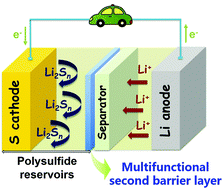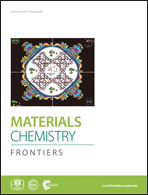Multifunctional second barrier layers for lithium–sulfur batteries
Abstract
Lithium–sulfur (Li–S) batteries have become one of the most promising candidates for next-generation energy storage devices due to their high theoretical energy density and cost effectiveness. However, the detrimental shuttle effect of lithium polysulfides during cycling and their deposition on the lithium anode have severely restricted the practical applications of Li–S batteries. Various efforts have been explored in the past few years to hinder the undesirable diffusion and shuttling of lithium polysulfides. The introduction of a second barrier layer has been demonstrated to be a successful approach to restrict the migration of polysulfides and fabricate high-performance Li–S batteries with enhanced cycling and rate performance. A comprehensive review of recent efforts regarding second barrier layers applied in Li–S batteries, either being an individual interlayer, a thin coating on the separator, or an integrated structure, is presented and discussed. Individual interlayers made by porous carbon, carbon/metal compounds and conductive polymers between the separator and the sulfur cathode as well as functionalized polyolefin and non-polyolefin based separators have been proposed. In addition, some advanced examples of interlayers with novel sandwiched/integrated configurations for Li–S batteries, which can not only enable a suppressed shuttle effect but also achieve enhanced energy density, are also reviewed.

- This article is part of the themed collections: 2018 Materials Chemistry Frontiers Review-type Articles and Advanced Battery Materials


 Please wait while we load your content...
Please wait while we load your content...